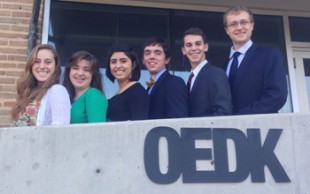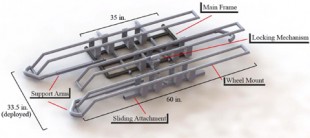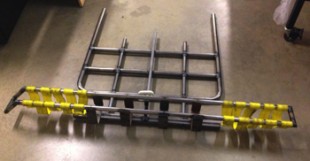Freshman team’s bike-rack design for METRO tops TxDOT College Challenge
A team of six Rice University engineering students took their first project — the design of a rack to transport three bicycles at a time via METRO bus — all the way to its logical conclusion and have won this year’s Texas Department of Transportation’s College Challenge.

TxDOT College Challenge winners, from left: Sharon Ghelman, Annabelle McIntire-Gavlick, Kivani Sanchez, Brian Barr, Kenny Groszman and Max Hasbrouck.
Now they’re starting the second half of their freshman year.
The team — bioengineering students Ken Groszman and Sharon Ghelman, mechanical engineering students Max Hasbrouck and Annabelle McIntire-Gavlick and chemical and biomolecular engineering students Kivani Sanchez and Brian Barr — took the $3,000 top prize with a presentation at the ninth annual Texas Transportation Forum in San Antonio Jan. 8.
The team was one of three finalists asked to develop innovative concepts that address the state’s mobility, connectivity and transportation safety issues. The other finalists were from the University of Houston and Austin College.
The students were motivated by a recent study by the Houston-Galveston Area Council that anticipates the region’s growth will make racks that can hold two bikes on current METRO buses insufficient to meet the needs of commuters. In fact, this week’s news is a double win for Rice, as the three-rack solution was one of several recommendations by a Houston Action Research Team (HART) of undergraduates who worked over the summer to help METRO improve bike-bus transit in the city.
“Ridership is up significantly systemwide, and people want METRO to solve the ‘last-mile’ problem,” said Matthew Wettergreen, a lecturer at Rice’s George R. Brown School of Engineering who works with freshman design teams at the Oshman Engineering Design Kitchen (OEDK). “You can get almost anywhere in Houston on the buses and trains, but that ‘last mile’ to and from your destination requires you to either drive or walk. Bikes are a great way to solve that problem, but there’s a limited number of bike racks on METRO rail and buses.”
He said three-bike racks from METRO’s current vendor wouldn’t work because of the buses’ windshield design. Folded up when not in use, the racks would impede the driver’s view.

An illustration from the Rice team's contest entry shows details of their three-bike rack. Click to view a larger version.
The contest required students to submit a project proposal and a video. It didn’t require them to actually build the project.
“One of the judges commented on that,” McIntire-Gavlick said. “He said, ‘It’s a good day when an engineer actually gets his hands dirty.’ I think they really appreciated the fact that we put so much time into this and that we have a working prototype to show all of our efforts. We had done testing on our prototype, too.”
The rack would take only a little more space than a two-bike unit when folded up because the spring-loaded unit for the third bike is collapsible. A rider would load it up by pulling a handle that allows the third rack to slide out. The wheels sit in a strap-supported channel and an arm extends over the front wheel to lock the bike into place.
The prototype cost less than $900 to build at the OEDK, and the students figure it would easily meet METRO’s cost requirement of roughly $1,100 per unit when scaled up for manufacturing.
The project’s future is now in METRO’s hands. “We discussed this with them at the end of last semester and the conclusion was that they’re going to spread the idea around the department,” Groszman said. “Hopefully, it will either be passed on to a design engineer to look into manufacturing or a different design team at Rice that can continue testing.”
METRO officials indicate they will do their part. “METRO is enthused by the success of the project and will assist by introducing the students’ ideas to manufacturers with a goal of providing more access to transit systems in the U.S.,” said Doug Peck, director of bus maintenance support. “We were glad to be a resource for the students and provided access to METRO’s fleet and Kashmere bus operating facility as well as documentation regarding our maintenance experience with current bike racks. It was great to see these young people working hard on new ideas and solutions for transit concerns.”
The students took on the task at the dawn of their academic careers at Rice. “What’s remarkable is that they had no experience manufacturing anything,” said Wettergreen, who got the pitch from Elizabeth Vann, director of civic research and design at Rice’s Center for Civic Leadership, based on the HART team’s proposal.
Vann and Robert Stein, Rice’s Lena Goldman Professor of Political Science, advised the HART team of biochemistry and cell biology student Skye Kelty, civil engineering students Maria Rangel and Laura Lopez and architecture student Austin Jarvis, all seniors. Over the summer they worked on their proposal to METRO and challenged the Engineering 120 class to come up with a three-bike rack in the fall.
“It was an especially challenging engineering project for freshmen,” Vann said. “In the beginning, I wondered if they were going to be able to pull this off. METRO had a lot of special requirements and demands in terms of cost, size, durability and function, so it was a lot to take on.
“But as the weeks went on, I could see they were making real progress. By the end it was just fantastic.”
That the Rice freshmen entered the TxDOT challenge at all was just good luck. “One of our teammates happened to see a flyer for the contest posted at the OEDK and said, ‘Hey, guys, we should enter this,'” McIntire-Gavlick recalled. “It was real last-minute. Then we made the finals and said, ‘Wow, let’s put some more work into this and see what happens.'”



Ongoing innovation is important towards better design and use, both in the use of material as in application.
I was impressed by the quality of the students work and the desire by METRO to work with Rice University to develop this innovative prototype.